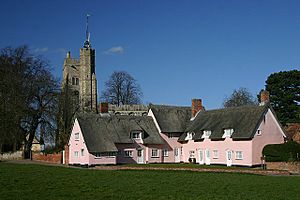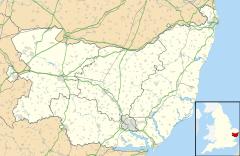Cavendish, Suffolk facts for kids
Quick facts for kids Cavendish |
|
|---|---|
 Cavendish High Street, seen from the green |
|
| Population | 1,026 (2011) |
| OS grid reference | TL805464 |
| District |
|
| Shire county | |
| Region | |
| Country | England |
| Sovereign state | United Kingdom |
| Post town | SUDBURY |
| Postcode district | CO10 |
| Dialling code | 01787 |
| Police | Suffolk |
| Fire | Suffolk |
| Ambulance | East of England |
| EU Parliament | East of England |
| UK Parliament |
|
Cavendish is a lovely village in the Stour Valley, located in Suffolk, England. It's a quiet place with a rich history, nestled in the beautiful English countryside.
Contents
What's in a Name? The Story of Cavendish
Have you ever wondered how places get their names? Experts who study place names, called toponymists, believe that Cavendish got its name a long, long time ago. It's thought that a man named Cafa once owned a special field here called an eddish, which was a pasture for animals after crops were harvested. So, "Cavendish" basically means "Cafa's pasture"! Over time, the spelling changed until it became the name we know today.
A Glimpse into Cavendish's Past

Cavendish has a fascinating history, especially linked to a famous event called the Peasants' Revolt in 1381. This was a time when many ordinary people stood up against the King and the unfair rules of the time.
The village was home to Sir John Cavendish, whose family later became the Dukes of Devonshire. Sir John played a part in stopping the Peasants' Revolt. The leader of the peasants, Wat Tyler, was arrested by the Mayor of London, William Walworth, after he threatened King Richard II. When Tyler resisted, Sir John's son, also named John, who was protecting the King, bravely stepped in.
After this, John Cavendish (the son) tried to escape the angry peasants. He ran to St Mary's Church in Cavendish, hoping to find sanctuary. Sanctuary meant that if you reached a church, you were safe from arrest for a short time. However, a few days later, on June 15, 1381, the elder Sir John Cavendish was captured in Bury St Edmunds and sadly lost his life. He is buried there. St Mary's Church in Cavendish received a gift from Sir John, and its chancel (the part of the church near the altar) was restored.
Today, the village has a United Reformed Church, where Catholic services are also held. There are also three traditional English pubs: the Five Bells, the George, and the Bull.
Cavendish is also a special place because Leonard Lord Cheshire and his wife Sue Ryder are buried in the village cemetery. They were famous for their charity work. There is a memorial to them inside St Mary's Church.
The Sue Ryder Foundation started in Cavendish as a home for people who had survived concentration camps. The charity still keeps some records of the people Sue Ryder helped.
Who Else Lived Here? Notable People
Cavendish has been home to some other interesting people throughout history:
- George Cavendish (born around 1497 – died around 1562) was an English writer. He is best known for writing a biography about Cardinal Thomas Wolsey, an important figure in English history.
- Sir William Cavendish MP (born around 1505 – died 1557) was a politician, a knight, and a courtier (someone who attended the royal court).
Fun Events in Cavendish
The village green in Cavendish is a busy place where many community events happen!
- Cavendish holds an annual summer fete (a type of outdoor fair or festival) in September.
- The local church also organizes a smaller fete earlier in the year.
- There is an exciting annual fireworks event that brings the community together.
See also
 In Spanish: Cavendish (Suffolk) para niños
In Spanish: Cavendish (Suffolk) para niños


